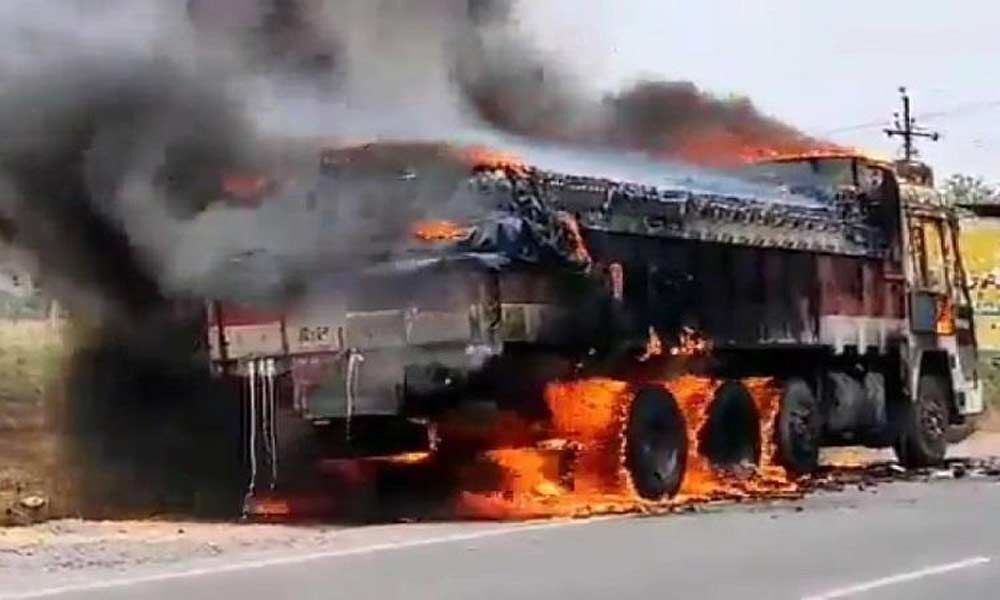Live
- India Faces Blow as Pacer Mohammed Shami Ruled Out for Remainder of Australia Series
- Farmer’s Day Celebrations Held at Palem Agricultural Research Center, Nagarkurnool
- Biden Pardon: Joe Biden Commutes Death Sentences of 37 Inmates, Including Child Killers and Mass Murderers
- South Korea: Yoon believes impeachment trial takes priority over martial law probe
- Strict Action for Non-Adherence to Time Management - DMHO Dr. Swarajya Lakshmi
- Joyful Semi-Christmas Celebrations at Sri Saraswathi International School
- Over 13.29 lakh houses approved for rural poor in Maharashtra: Shivraj Chouhan
- District Collector Urges Timely Completion of Indiramma Housing Scheme Survey
- Digital Arrest Scam: Hyderabad Man Duped of ₹7 Lakhs by Fake Crime Branch Police Callers
- Sukhbir Badal seeks President's Police medal for officer who saved his life
Just In
Safety measures to avoid vehicle fires need attention


At a time when the searing sun appears to be mightier than ever, the fire safety measures, especially on every moving vehicle on the road, holds significance.
Rajendranagar: At a time when the searing sun appears to be mightier than ever, the fire safety measures, especially on every moving vehicle on the road, holds significance.
On May 26, one person sustained serious burns when the car in which he was travelling caught fire after the vehicle rammed into a container lorry on ORR (Outer Ring Road) under the limits of Rajendranagar Police Station. In the blaze, the car was fully gutted and the lorry was burnt partially. In 2017, a car was gutted after it caught fire on the PVNR Expressway. On being alerted, fire-fighters rushed to the spot and doused the flames.
The moving vehicles often caught fire for various reasons and the incidents comparatively increase during summers, when the temperatures start souring gradually and reach crescendo. Usually mechanical or electrical issues with the vehicles often caused the fire.
Though the Motor Vehicle Act (MVA) doesn't promulgate any compulsion of carrying such fire safety apparatus in the motor cars and light motor vehicles, it says about keeping the engine and the electric components in a good condition. The violations would cause many technical problems in the vehicles, thereby harm the vehicles and the passengers.
"We could only implement safety if the rules allow us to do so. As far as my knowledge goes, there is no such provision that makes fire extinguisher compulsory in light motor vehicles. The rule book clearly mentions about such security tools to be affixed only in particular mode of public service vehicles, such as school buses, and to that extent, we are enforcing," said Rangareddy Transport Commissioner Praveen Rao.
According to the Motor Vehicle Rules 1989, every public service vehicle and goods vehicle, other than cabs and light motor vehicles, shall be fitted with a fire extinguishing apparatus. However, the rules do ask for a need to keep the vehicles in good condition to avoid any onboard incidents in the interest of drivers as well as passengers.
At times, when a vehicle can catch fire, as a result of powerful crash and the subsequent burning of rubber or plastic components, inside the vehicle, then the situation may turn more terrible. In such cases, the lives of all the on-board passengers are at high risk and only the fire safety tools kept under the vehicles could come to timely help to prevent fire from spreading further and to come out safely without any harm.
Unfortunately, many car owners pay no attention towards the importance of fire safety tools in the vehicles and move on the wheels throwing all the safety rules to the wind.
Fire in cars while driving is the biggest threat to the life of on-board passengers, especially during summers. The safety tools are considered to be the best possible mean to escape from any untoward incident at the very time the fire caught the vehicle. The timely use of the fire safety tool – a tiny fire extinguisher fixed to the driver's seat in the car – could help defuse the flames before it turns into inferno.
Steps to control fire
Sometimes, even the best precautions may not help prevent fire. In an unfortunate event you have a car fire, then here's what you should do:
- Your first concern should be safety of the occupants.
- Keep a fire extinguisher handy. These days you get spray-can fire extinguishers filled with halo gas that can fight multiple types of fires, including oil and electrical fires.
- Keep a life hammer in the car. A life hammer is a tool that has a pointed hammer at one end to break glass and a seat belt cutter at the other end to quickly free trapped occupants.
- In many cases of fire, the central locking system gets jammed – and it's quite possible that could happen in a panic situation. Also, as many door handles are made of plastic, a fire will quickly melt them, rendering them useless. In such cases, breaking out of the windows is the only way out.
- If you don't have a life hammer, keep the wheel spanner or similar heavy tool right next to the driver's seat or in the door pocket.
- To extinguish a small fire, you can use a regular fire extinguisher. If it is an electrical fire, you have to douse the flames with sand or water. But, if it is an oil fire, water will make it worse and spread the fire. In such cases, sand would be better. However, if the fire is raging out of control, don't try saving the car, save yourself!
Precautions to avoid fire
- Do ensure regular checks and get regular service of the car done, so that there are no loose connections or exposed wiring in the car, especially around the battery.
- Do check functioning of the cigarette lighter (if equipped) in your car, as in many cases these push-in lighters get jammed, overheat and start a fire in the car.
- Don't smoke! That is an obvious fire hazard. But, if you are a smoker make sure you keep the lighter or match box safely out of the way and avoid lighting up when you are driving.
- Don't get unauthorized accessories installed. All accessories, such as additional lights, music systems and central locking mechanisms, should be installed by authorized personnel and with the use of proper plug-in, snap-fit connectors.
- Do not carry inflammable material in the car like a spare can of petrol or domestic LPG cylinders in the car.
- Do not keep spray cans in a car that's parked in the sun. Many of these cans of lubricant, dashboard polish or even deodorants have inflammable material in them and are under pressure. When kept in the hot sun, these cans can explode and start a fire in a parked car.
- When a car is being repaired or if you are making electrical connections, it is best to ensure that the battery is first disconnected, as sparks in the engine bay could ignite petrol fumes.
- Also, check for fuel leaks in the engine, near the fuel pump, injectors and along the fuel lines and don't ignore them.
- If you drive a CNG or LPG-powered car, do ensure the cylinder meets all the compliance norms and is regularly checked.
- Stay alert. There's always a smoke before the fire. Pull up and check the moment you get any kind of burning smell.

© 2024 Hyderabad Media House Limited/The Hans India. All rights reserved. Powered by hocalwire.com






